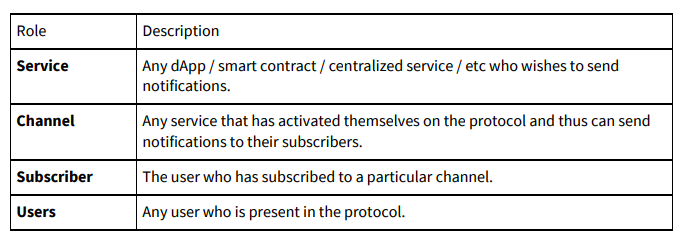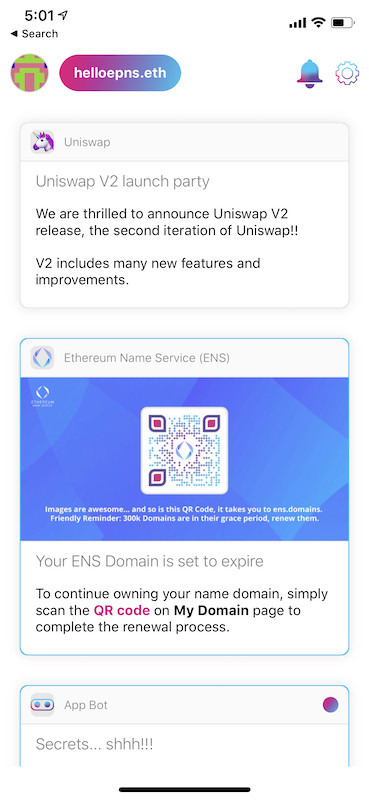链上信息推送服务EPNS,让你第一时间知道自己被爆仓……
如果你是通过 Odaily 星球日报APP的信息推送(push)看到了这篇文章,那么你或许应该去思考这么一个问题——在传统互联网世界,我们可以通过各类应用频繁的信息推送了解各行各业正在发生的事情,但在区块链世界,从协议到用户有没有一个通用的信息推送机制(比如价格提醒)?
至少目前来看,答案是否定的。
随着 DeFi 的繁荣,想必大多数读者都曾亲身体验过一些 DeFi 产品。与中心化应用相比,DeFi 产品在协议层面提高了资产的安全性,但在实际使用中却没有前者那般便利。举几个例子:
当你使用某款 DEX 交易或做市时,DEX 无法随时通知你某个代币的价格波动状况以及做市的无常损失程度;
当你使用某款去中心化合约交易平台时,平台也没有办法随时通知你仓位是否安全;
当你使用某款借贷协议时,协议也无法在币价大幅波动时随时通知你清算风险的实时变化;
当你使用 NFT 交易平台竞拍某款热门作品时,平台仍然无法随时通知你的投标价格是已被接受还是已被其他出价超越;
当你在等待更低的 gas 费用时,没有人会主动告诉你当前的 gas 价格是否已降至了你的心理预期……
所有的一切,都需要你主动去链上查看,就用户体验来说并不够完善。
那么,有没有什么解决办法呢?

Odaily 星球日报最近留意到,一家名为 Ethereum Push Notification Service(EPNS)的项目上个月刚刚完成了 75 万美元的种子轮融资,这家项目想要做的事情正是在以太坊生态中构建一个去中心化的信息推送协议,允许用户(即钱包地址)接收来自各种 Dapp、智能合约甚至是中心化服务的信息通知。
EPNS 的工作逻辑其实相当简单,理解协议内部的四个关键词即可:

服务方(Service):顾名思义,即希望向用户推送信息的 Dapp、智能合约或中心化服务。举个例子,Aave 希望可以向用户通知清算风险的实时变化,那么就可以选择集成 EPNS 协议。
频道(Channel):即 EPNS 协议已激活的信息推送服务,用户可以选择订阅自己感兴趣的频道。继续举例,如果上文里的 Aave 完成了对 EPNS 的集成工作,那么就会激活一个频道,Aave 用户便可以通过订阅这个频道实时关注自己账面的清算风险。
用户(Users):即 EPNS 协议内的所有参与者,是所有不同频道订阅者的总称。
订阅者(Subscriber):订阅者是用户的子集,是指已订阅了某个具体频道的用户,比如上文提到的 Aave 频道。
对于用户来说,使用 EPNS 的方式是下载其移动端或桌面端的 APP,再通过 App 链接自己的钱包地址,订阅感兴趣的频道,之后就可以实时接收来自各种 Dapp、智能合约以及中心化服务的信息通知了,体感上与互联网世界的应用通知完全一样。大概会长下边这样子:

EPNS 协议给予了信息推送的双方很大的自由度。服务方可以自由决定向用户传达什么样的信息,不过每次推送都需要支付一定的费用(以 ETH 或 DAI 计价);用户方也可以自由决定是否订阅某个频道。
值得注意的是,由于服务方可以自由选择自己推送的内容,所以 EPNS 频道理论上也可能成为项目方的广告板,当用户对频道不满时可以选择取消订阅,还可以描述具体理由并送上 1 星好评(没有 yygq,EPNS 的评分范围是 0-1,分值越低代表频道越优质)。
EPNS 协议的宣传标语是「Subscribe、Notify、Earn」,Subscribe(订阅)和 Notify(通知)很好理解,Earn 的内容就要涉及到 EPNS 协议的原生代币了。EPNS 的代币名字非常贴切——PUSH,PUSH 是该协议内部参与者之间的交易媒介(简单来说就是订阅频道的支付方式),EPNS 也会为积极参与协议的用户分发一定的 PUSH 奖励,持有 PUSH 代币将有权力参与协议未来发展的各项治理,包括决定全文所提到的服务方需支付的推送费用。
目前,EPNS 协议已在以太坊测试网 Ropsten 上运营,已激活的一些频道包括「Compound 流动性警报」、「特定钱包的资金跟踪」、「ENS 域名到期提示」以及「gas 费用预警」等等。
官网信息显示,EPNS 协议计划在 2020 年末或是 2021 年初上线以太坊主网,由此来看距离 EPNS 的正式发布应该已经不远了。



